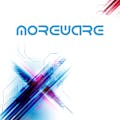A few months ago we were contacted by a luthier (Nadar Guitars). After reading our series of articles on the use of WS2812b addressable LEDs, he asked us for advice. The idea: set up a parade of intelligent LEDs (WS2812b) driven by one (or more) Arduinos, to increase the aggressiveness of an electric guitar for a Heavy Metal band.
The problemsThe space available for the circuitry, the use of an electronic switch based on a system configurable IR remote control, the typical hum noise emitted by the transmissions between the LEDs and Arduino, centered in the 1kHz range, the use of a separate power supply for the LEDs. After a brief chat with Gianluca (the luthier), we decided to split the project onto two Arduino Nano boards (one for the handle and one for the plate). As an excellent luthier, Gianluca proceeded to use his own CNC system to create the right arrangement of the LEDs on the body of the guitar, and provide a lateral-rear section for access to the electronics.
For the neck, the classic lighting program with fixed light on the "frets" was adopted, with the addition of a line of the same color that runs laterally along the entire length. An Arduino was delegated to this work.
The "heart" of the creation, however, was coded inside the second Arduino: to make the presentation more interesting, we were asked for the availability of multiple display programs (eight) that could be managed from the stage via an IR remote control, so as to be able to manage the different moods of the songs.
Finally, it was necessary to design a system to manage the energy required by the LEDs and Arduino boards, and fast charging, through a LiPO battery that was sufficiently powerful but not too invasive. We chose to use a classic 5000 mA 3.7V battery and a boost to bring the supply voltage of the circuit and boards to 5 V. For those interested in the possible circuits, we talked about it in this article.
TroubleshootingAs we have previously seen, several problems arose between the idea and the final project, all of which were faced and resolved by our team.
The use of low-power Nano cards allowed us to limit power consumption in order to allow the battery to last throughout the show.
The IR remote control allowed us to insert different light display programs onto the board and thus guarantee a greater choice of maps and light patterns
The use of an independent boost makes the instrument flexible for charging: simply insert a mini jack and the battery recharges.
The buzz of LEDs… remains a little industrial secret.
From an apparently simple project we found ourselves having to resolve numerous technical problems. What matters is that the band that played last Saturday was pleasantly surprised and satisfied with the work. We showed a way of making with Arduino that would otherwise not be accessible, we had fun and perhaps gave some new ideas to our readers.











_3u05Tpwasz.png?auto=compress%2Cformat&w=40&h=40&fit=fillmax&bg=fff&dpr=2)
Comments
Please log in or sign up to comment.